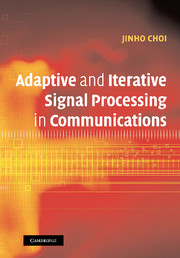Book contents
- Frontmatter
- Contents
- List of figures
- List of tables
- Preface
- List of symbols
- List of abbreviations
- 1 Introduction
- I ISI channels and adaptive signal processing
- II Iterative signal processing for ISI channels
- III Other interference-limited systems
- Appendix 1 Review of signal processing and the Ƶ-transform
- Appendix 2 Important properties of matrices and vectors
- Appendix 3 Background for probability and statistics
- References
- Index
1 - Introduction
Published online by Cambridge University Press: 23 November 2009
- Frontmatter
- Contents
- List of figures
- List of tables
- Preface
- List of symbols
- List of abbreviations
- 1 Introduction
- I ISI channels and adaptive signal processing
- II Iterative signal processing for ISI channels
- III Other interference-limited systems
- Appendix 1 Review of signal processing and the Ƶ-transform
- Appendix 2 Important properties of matrices and vectors
- Appendix 3 Background for probability and statistics
- References
- Index
Summary
Signal processing and communications are closely related; indeed, various signal processing techniques are adopted for communications at both transmitters and receivers. In particular, the role of signal processing is very important in receiver design. For example, signal processing techniques are applied to carrier and clock synchronization, channel equalization, channel estimation, interference rejection, etc. It is our aim in this book to introduce adaptive and iterative signal processing techniques for receiver design in interference-limited environments.
Communications in interference-limited environments
Generally, the performance of communication systems is limited by the interference, of which there are various sources. For example, multipaths of a radio channel cause inter-symbol interference (ISI), as shown in Fig. 1.1. The received signal becomes a sum of delayed transmitted signals with different attenuation factors. Although the background noise is negligible, the ISI can degrade the performance because the received signal is distorted by the ISI.
In a multiuser system, such as the one shown in Fig. 1.2, the other users' signals become interfering signals. Thus, it is important to alleviate interfering signals to achieve a satisfactory performance.
Throughout this book, we introduce a few communication systems under interference-limited environments. For each communication system, adaptive and/or iterative signal processing methods are discussed to overcome the interference.
We will briefly review some approaches for the interference mitigation in each interference-limited channel below.
ISI channels
A nonideal dispersive communication channel can introduce the ISI, and the receiver has to mitigate the ISI to achieve a satisfactory performance. Since a dispersive channel is seen as a linear filter, a linear filtering approach can be used to equalize a dispersive channel.
- Type
- Chapter
- Information
- Publisher: Cambridge University PressPrint publication year: 2006



